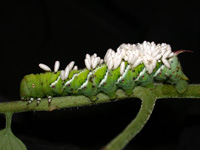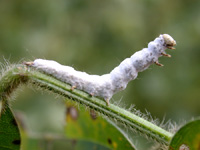Biological Control
Biological control occurs in nature all around us. Animals preying on or becoming parasites to other animals, or diseases that kill animals or plants are all agents of biological control, or more commonly called biological control agents. When we refer to the balance of nature, we are often talking about natural biological controlone organism in the environment controlling another. In IPM, biological control is a method of managing pest populations by manipulating parasites (parasitoids), predators, or diseases (pathogens) in the pests environment, to the detriment of a particular pest population.
Parasitoids (Parasites)

This tiny wasp develops within the caterpillar slowly killing it. The white pupae on the outside of the caterpillar are evidence of the infestation. They will each emerge as an adult and continue the cycle. Parasitoids are often called parasites, but the term parasitoid is more technically correct. By definition, insect parasitoids have a free-living adult stage and an immature life stage that develops on or within an insect host and ultimately kills it. After feeding on host body fluids and organs, most parasitoids leave their hosts to pupate or emerge as adults. Most beneficial insect parasitoids are wasps or flies, although other insects may have life stages that are parasitoids as well. Parasitoids usually complete their life cycles much more quickly and increase their numbers faster than predators, even though a parasitized host does not die as quickly as those eaten by predators.
Parasitoids are often the most effective natural enemy of pest insects, even though they may not be readily visible. Sometimes pest populations actually increase after pesticides are applied. This can happen when a chemical insecticide kills the parasitoids before they can kill their host, or the pest insect. Once free of the natural parasitoids, the pest insect is then free to increase in number.
Predators
Insect predators can be found in almost all agricultural and natural habitats. They are usually bigger than their prey and consume them very quickly. Predators are known for their ability to actively search out and destroy their host. Some, such as the praying mantis, are generalist predators, meaning that they will feed on nearly any insect that they can catch. Others are specialists, meaning that they will search out only a certain species or a certain life stage of an insect on which to feed. Their ability to search and destroy makes them very effective natural enemies of insect pests. Predators should be credited with controlling many would-be pests. Common predators include beetles, bugs, lacewings, flies, midges, and wasps.
Most beneficial predators will consume many pest insects during their life span, but some predators are more effective at controlling pests than others. Many predators may have only a minor impact on a pest population by themselves but they still contribute to overall pest management when their effect is combined with the effects of other predators and/or biological control agents.
Predators, in either the larval or adult stage, search out and eat insect pests. Some have a voracious appetite and can consume many pests, ultimately reducing the pests' population.
Pathogens
Pathogens are naturally occurring biological agentssuch as bacteria, viruses, fungi, protozoans, and nematodesthat infect and kill insect hosts. Like humans, insects can be infected by pathogens. Under favorable conditions, such as high humidity or pest abundance, pathogens may quickly multiply to cause disease outbreaks or epizootics that can decimate an insect population.
Entomologists and agriculturists are just beginning to truly recognize the value of naturally occurring pathogens in the prevention of insect outbreaks. Insect pathogens are one of the reasons that pest populations do not become problematic every year. Many pathogens have been identified, while many more are at work in the environment but have yet to be discovered.

Grub infested with insect pathogenic nematodes. Of those that have been identified, some pathogens have been mass-produced in laboratories and are now available to pest managers for use against insect outbreaks. Some of these microbial insecticides are still experimental, while others have been available for many years. Formulations of the bacterium Bacillus thuringiensis, or Bt, for example, are widely used by gardeners and commercial growers. And several species of nematodes can be purchased to control many different pests in landscapes, turfgrass, greenhouses, and urban structures.
As a group, these products are referred to as biorational or microbial insecticides because they are applied in a manner similar to conventional pesticides even though they contain a microscopic life form. One main advantage of insect pathogens is safety. They are relatively specific to select groups of insects and sometimes even target specific life stages. As such, they do not harm the environment or nontarget animals, such as beneficial insects, pets, wildlife, or humans.
Unlike chemical insecticides, microbial insecticides can take longer to kill their target pest. Also, they are usually more expensive to use, and they must be applied to an environment in a way that will allow them to survive. To be effective, most microbial insecticides must be applied to the correct life stage of the pest, so pest managers must understand the life cycle of the target pest.
Microbial insecticides are compatible with the use of predators and parasitoids, which may help to spread some pathogens through the pest population. While beneficial insects are not usually affected directly because of the specificity of these microbial products, some parasitoids may be affected indirectly if their hosts are killed. Insecticide applicators should note that although microbials are nontoxic to humans in the conventional sense, safety precautions should always be followed to minimize exposure.
Pathogens can be important management tactics for many insect pests and are important components of an IPM strategy.
Biological control, the practice of using living organisms to control pests, is not a new science, but it is a control tactic that is beginning to see greater acceptance in insect pest management. Evidence of biological control efforts exists from ancient times and significant control was achieved through the introduction of biological controls in the early part of the twentieth century. However, with the introduction of modern synthetic chemical insecticides, especially during the latter half of the twentieth century, biological control became a largely forgotten science. New chemical insecticides were cheap and appeared to be cure-alls. But this perception was unfounded, and as the disadvantages of synthetic chemicals became more evident and public demands for more environmentally friendly methods of pest control grew, biological control agents were sought after once again.
Biological control offers many advantages over conventional chemicals. The most important advantage is that biological control methods can be less hazardous, both to people and to the environment. Once introduced, they can continue to be effective without further human intervention. Some instances of introduced biological control agents have been successful, while others have been disappointing. Of course, care must be taken to avoid introducing biological control agents into the environment only to realize later that these controls have become pests themselves. Case in point: Asian lady beetles were introduced into America to help manage aphids in agricultural crops. Now they have become a common nuisance pest in homes throughout much of the United States.
Predatory or parasitic organisms feeding directly on pests have shown promise for controlling pest populations. In nature, many different parasites or predators can be found, each with a unique ability to persist, seek out, and kill potential hosts. Pest-specific diseases also have been used with varying degrees of success in the management of pest populations. Successful organisms, mostly fungi and bacteria, have been propagated in the laboratory and are now commercially available.
Naturally occurring biological control agents probably are more important than most people imagine. Insect pests usually are controlled naturally by beneficial arthropods and diseases, which can moderate or often prevent outbreaks of pest populations. It is telling that landscapes that are not intensively managed are seldom prone to serious pest outbreaks. Society has learned, through hard-won experience, that when the natural balance is upset by chemical or cultural interference, pests readily move in. Therefore, careful consideration must be given to how each management input can affect a systems beneficial organisms.
Identifying and conserving naturally existing plant and animal biological control organisms are logical steps in IPM implementation. Maintaining a balance between pests and their natural controls will diminish the need for pesticides, save money, and greatly benefit the ecosystem.
Overuse or misapplication of nonselective chemicals interferes directly with the potential of naturally occurring beneficial organisms. Pesticides have been shown to have the opposite consequences of their intended use if they kill the naturals controls that hold a pest population in check. Releasing a pest population from its natural biological checks and balances may set the stage for a dramatic and often devastating resurgence of a pest population.
|
